Gadgetstress team is glad to present you a new way of testing electronic devices. Today we are going to torture the two samples of Alcatel OT-708, one of the cheapest (if not the cheapest) touchscreen cell phones available in the market today. Its specification is similar to Samsung C3300K Champ’s.
The Alcatel OT-708 comes in a thin white cardboard box (Pic. 1) in which you can also find a wall charger and earphones (Pic. 2). The phone is powered by 750 mAh LI-Ion battery and has a resistive touchscreen with 240-by-320-pixels. It is also equipped with a 1.3-megapixel camera and boasts the 16 blue LEDs under the screen. You can also find a metallic stylus, housed in the phone’s underside. A white coloured rim round the black front and the black casing makes the gadget look stylish. The whole body is made of matted plastic (Pic. 3, 4).
We developed different stress tests for each Alcatel OT-708 sample. Some of them are new. We hope to get more accurate results than we showed you in the previous test reviews. As usual, almost every test is divided into 3 stages.
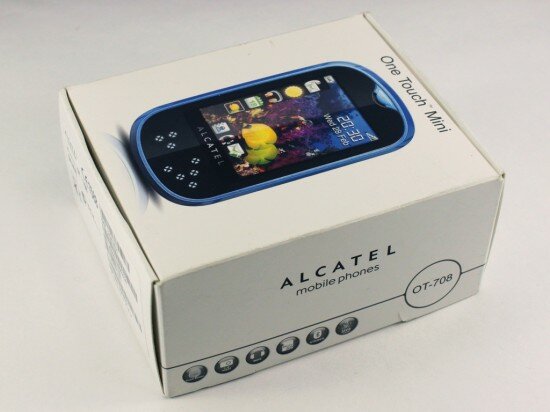
Рic. 1. Package box

Рic. 2. Accessories
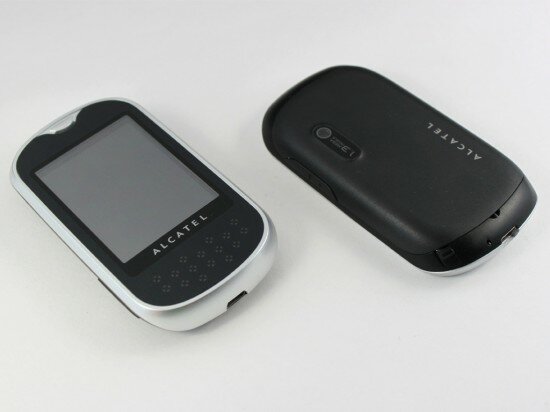
Рic. 3. The Alcatel OT-708’s front and rear panels
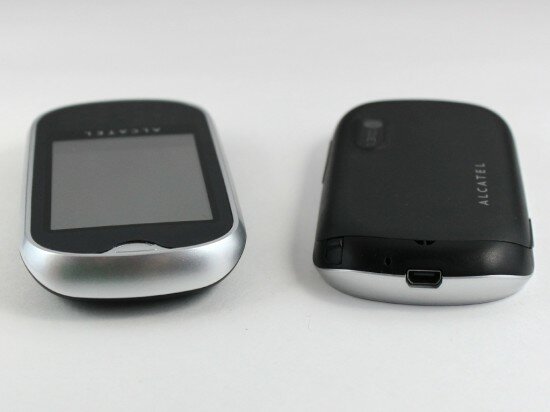
Рic. 4. The Alcatel OT-708’s edges
The Alcatel OT-708’s stress tests (the 1st sample)
1. Reception quality
We decided to start with testing the phone’s signal quality instead of performing our classic stress tests. Reception and call quality are the most important features of a mobile phone that customers should pay attention to.
To check the Alcatel OT-708’s reception we placed it inside a cardboard box and covered it with foil. This box served as an obstruction to the signal from a tower. In order to give the phone a small chance to receive our calls we carved a hole in the box that was 40 x 50 mm (1.57 x 1.97 inches). When we started making calls the signal indicator on the phone’s screen displayed 3-4 bars. It meant that the gadget’s signal strength was quite enough to receive all incoming calls with no problem (video 1). Next we decreased the size of the hole in the box to 20 x 20 mm (0.787 x 0.787 inches) and made some calls again. As a result, the signal reception fell to 2 points (video 2). Finally we decreased the size of the hole to 15 x 15 mm (0.59 x 0.59 inches) and the indicator of signal strength displayed only 1-3 points (video 3). Nevertheless, the handset successfully received all incoming calls and we didn’t witness any dropped calls.
Video 1. Reception quality (stage 1)
Video 2. Reception quality (stage 2)
Video 3. Reception quality (stage 3)
Grade (stage 1): 3 (with 3 being the highest possible grade)
Grade (stage 2): 3 (with 3 being the highest possible grade)
Grade (stage 3): 3 (with 3 being the highest possible grade)
2. Freeze test
Everybody knows that electronic gadgets show poor performance in cold weather. In freezing temperatures, cell phone batteries deplete quicker than usual (that is, their capacity goes down much faster compared to moderate temperatures).
We checked the Alcatel OT-708’s ability to survive cold by testing it in a freezer. The phone was left there for 2 hours in speaking mode and for 20 minutes in standby mode. The temperature in the freezer was -15…-20 °С (5….-4 °F).
After the test we measured the Alcatel’s temperature. It was -17 °С (1.4 °F) (video 4). The capacity of the battery went down by half. However, when we started to examine the phone more carefully it gave us a warning that the battery was absolutely empty. Moreover, the display malfunctioned a lot because the touchscreen was frozen. The cold had a very bad impact on its flexibility. We made a call and noticed that the handset vibrated much louder than before the test.
When we warmed the Alcatel to a room temperature, the capacity of the battery increased and the devise started to perform pretty fine again with it.
Video 4. Here’s how the phone looks like after the freeze test.
Grade: 2 (with 3 being the highest possible grade)
3. Short circuit of the battery charger
In this stress test we checked reliability of the battery charger by connecting its terminals with the forceps for a moment (video 5).
The battery charger passed this test with no problem. Watch the video to make sure that the short circuit didn’t break the charger and the phone.
Video 5. Short circuit of the battery charger
Grade: 3 (with 3 being the highest possible grade)
4. Short circuit of the battery
In this test we connected the positive (+) and negative (-) terminals of the battery together with the forceps for one second (video 6).
The short circuit did not break the battery. The phone performed fine with this battery inside it. This is how we checked reliability of the battery.
Video 6. Short circuit of the battery
Grade: 3 (with 3 being the highest possible grade)
5. Charging the phone with incorrect voltage
Some mobile battery chargers (car chargers, cheap chinese wall chargers etc.) produce greater voltage than it is declared by their manufacturers. But you should charge your handset with a correct voltage level. Otherwise, you risk to damage the charger and the cell phone.
We tried to check the reaction of the Alcatel OT-708 to charging at a higher rate. Actually we plugged one end of the battery charger into the regulated power supply and the other end into the phone. The regulated power supply was plugged into the outlet.
At first we fixed the charging voltage at 5 V and started to slowly increase the voltage to the ultimate point (8 V). When reached 6.3 V the phone refused to charge (it stopped to consume current). Nevertheless the battery indicator on the phone’s screen showed that it was still charging. Despite this bug we continued the experiment and raised the voltage until we reached 8 V. Unfortunately, there was a small current leakage that indcated about the problems with electrical circuit.
Next, we decided to power the cell phone battery with little voltage in order to find the lowest charging rate. We fixed the charging voltage at 5 V again and moved to the opposite direction (started to decrease the voltage very slowly). Sometimes the phone gave us warnings that the battery charger wasn’t plugged, then plugged again and so on. At 4.4 V the Alcatel OT-708 refused to charge at all.
Video 7. Charging the phone at a higher rate
Grade: 2 (with 3 being the highest possible grade)
6. Providing the phone with incorrect power
You can seriously damage your handset if you supply it with greater power than it can accept. You may do it by putting the wrong (much more powerful) battery in your cell phone or use another source that provides a great power to your mobile device. We don’t think that it can happen to you in real life but still we decided to check how much power the Alcatel OT-708 can accept.
We lifted the battery out of its compartment and connected the regulated power supply into the phone directly. Then we started to increase the power slowly from 4 V to the ultimate point of 7 V (video 8).
To our surprise the phone showed perfect results. It consumed the right amount of current all the time and performed with no problem. So the Alcatel OT-708 can accept a relatively great power.
Video 8. Providing the phone with incorrect power
Grade: 3 (with 3 being the highest possible grade)
7. Leaving a cell phone out in the rain
Our reviews always include tests on water splash resistance and this one is not an exception. But today we are going to perform three water tests instead of one. At first we left the Alcatel out in the artificial rain for one minute (video 9).
After the test we examined our gadget and noticed that the speaker was very far from being loud. We saw many drops of water under the battery (Pic. 5). No wonder that the exposed USB port was also wet (Pic. 6).
However we dried the phone with warm air and examined it for the second time – the speaker became loud again. The devise stayed functional.
Video 9. Leaving the Alcatel OT-708 out in the artificial rain
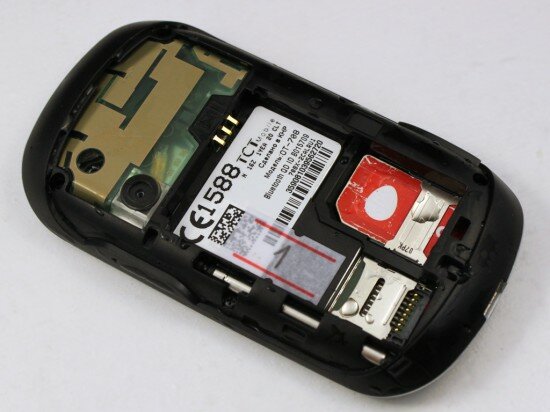
Pic. 5. Drops of water under the battery
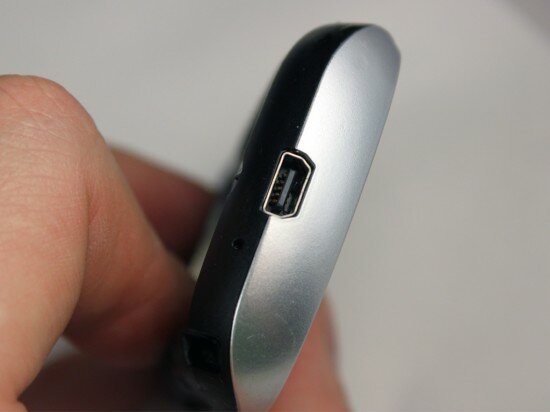
Pic. 6. Water in the USB port
Grade: 3 (with 3 being the highest possible grade)
8. Immersion in water
In this test we completely submerged the Alcatel OT-708 under water and left it there for 20 seconds (video 10).
As a result, we witnessed the same problem with the speaker again. However, the battery and the connectors weren’t so wet as in the previous test. The handset sustained no damage and performed pretty fine.
We dried the phone out and examined it again – the speaker got better.
Video 10. Immersion in water
Grade: 3 (with 3 being the highest possible grade)
9. A full submerge to a depth of one meter
This time we increased the depth of submersion from 4 cm (1.57 inches) to 1 m (3.28 feet).
We put the phone in a thin glass tube and filled the tube with water so that the phone lay at a depth of 1 m (3.28 feet) (video 11). This time we kept our gadget under water for 20 seconds again (video 12).
To our great surprise the Alcatel sustained no damage. It performed with no problem even under water.
We should say that a lot of water penetrated the phone (Pic. 7). However, when we dried it out there were no signs of submersion. The speaker, the touchscreen – everything worked fine.
Video 11. Thin glass tube filled with water
Video 12. A full submerge of the Alcatel OT-708 to a depth of one meter

Pic. 7. Drops of water under the battery
Grade: 3 (with 3 being the highest possible grade)
10. A full submerge to a depth of two meters
Only IPx7 waterproof cell phones are to put to this test.
Grade: –
11. Immersion in beer
The Alcatel OT-708 successfully passed all the water tests. Don’t worry much if you drop it in water. But what would happen if you spilt beer on it or drop it in a glass of beer? You never know. You shouldn’t eliminate it.
We poured some beer in a plastic container, dunked the phone under beer and left it there for 10 seconds (video 13).
Even beer didn’t damage the Alcatel. The battery stayed almost dry. Only the top part of the phone got wet (the area near its antenna). We didn’t see a lot of water in the USB port and the phone worked fine with the data cable plugged.
After the test we carefully washed the phone with water and dried it out.
Video 13. Immersion in beer
Grade: 3 (with 3 being the highest possible grade)
12. Disassembling. Build quality
All the stress tests of the Alcatel OT-708 (the 1st sample) are over now. We can only disassemble the device and examine the state of its innards (Pic. 8).
Despite the low price of the phone its build quality is quite satisfactory. The front and the back panels are attached with 6 screws. The display, the touchscreen and the camera are removable. The gadget is armed with only one speaker which is used for transmitting a caller’s voice and for playing ringtones. All the main elements of the circuit board are protected by the shields which are non-removable. So it will be difficult to repair the phone if something breaks inside it. But would anyone bother about mending such a low end device as the Alcatel OT-708?
When we examined the circuit board we noticed the signs of corrosion. This is the result of the water and beer tests (Pic. 9). However, the handset can successfully work with this circuit board.
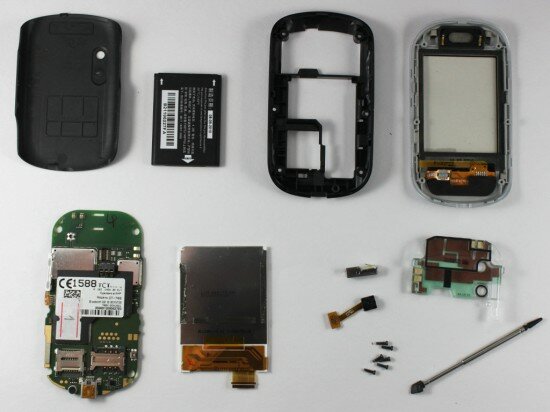
Pic. 8. The Alcatel OT-708 disassembled
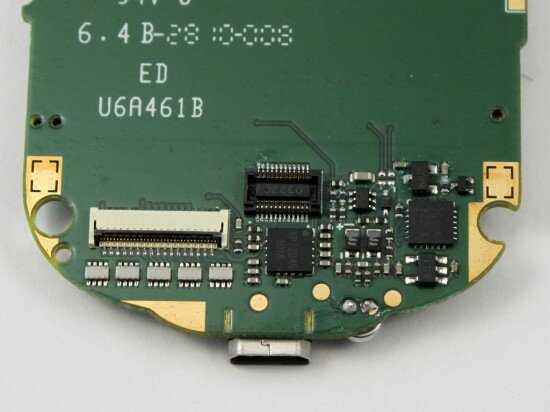
Pic. 9. The signs of corrosion on the circuit board
Grade: 3 (with 3 being the highest possible grade)
Stress tests of the Alcatel OT-708 (the 2nd sample)
1. Reception quality
We checked the reception quality of the 2nd Alcatel OT-708 sample. We put the phone in absolutely the same conditions as the 1st Alcatel sample. We used the same box. The dimensions of the hole were 40 x 50 mm (1.57 x 1.97 inches). Then we reduced the hole to 20 x 20 mm (0.787 x 0.787 inches) and finally we made it 15 x 15 mm (0.59 x 0.59 inches). The smaller the hole is, the weaker the signal from a tower.
The result was pretty much the same as in the previous test. Both Alcatel samples have fine reception even if the signal is weak.
Grade (stage 1): 3 (with 3 being the highest possible grade)
Grade (stage 2): 3 (with 3 being the highest possible grade)
Grade (stage 3): 3 (with 3 being the highest possible grade)
2. Talk time
Talk time and standby time are the two most important criteria of choosing a cell phone. These factors depend not only on the capacity of the battery but also on the amount of energy consumed by the phone. Everybody wants his/her handset work without charging as long as possible. We discovered how much talk time is provided by the Alcatel OT-708.
At first we fully charged the battery. Then we found a place with good reception conditions and put our handset there. Finally we made a call and waited. Our mobile network operator disconnected us each time after an hour of “talking”. So we had to call back again every hour. We didn’t change the default settings because they are timesavers.
At last we made 8 calls and talked for 8 hours. When we started to call for the 9th time the phone gave a warning that the battery was empty and stopped calling. Nevertheless, the handset didn’t switch off and continued working in standby mode with no problem.
The talk time of 8 hours that is declared by the Alcatel is really true and our test proved it.
Grade: 3 (with 3 being the highest possible grade)
3. Drops on the carpet
The first thing that usually comes to people’s minds when they hear about cell phone’s stress tests is a crash. Mobile devices are most often crashed in the result of knocks or bumps. Manufacturers try to solve this problem and make their products more rugged. But not all of them manage to produce reliable gadgets.
We successively dropped the Alcatel OT-708 on the carpet with each face, edge, and corner from 100 cm (3.28 ft), 150 cm (4.9 ft) and 200 cm (6.56 ft) (video 14 – 16).
The phone successfully survived the drops from 1 m and 1.5 m. The problems occured only when we dropped it from 2 m. This removed the back cover for several times. The stylus fell out of its port and when we put it back it didn’t fit snug anymore. It was not loose enough to fall out and it was still slightly locked into its place but it started to produced a noise when we shook the phone. As for the rest, the Alcatel showed no visible damage and stayed absolutely functional.
Video 14. Drops on the carpet from 100 cm (3.28 ft)
Video 15. Drops on the carpet from 150 cm (4.9 ft)
Video 16. Drops on the carpet from 200 cm (6.56 ft)
Grade (stage 1): 3 (with 3 being the highest possible grade)
Grade (stage 2): 3 (with 3 being the highest possible grade)
Grade (stage 3): 3 (with 3 being the highest possible grade)
4. Drops on the tile
In this test we successively dropped the Alcatel OT-708 on the glazed tile with each face, edge, and corner from 30 cm (11.8 inches), 50 cm (1.64 ft) and 100 cm (3.28 ft) (video 17 – 19). All in all we made six drops from every height.
During the drops from half a meter the back cover fell off only once. But when we started to drop the phone from 1 meter the back cover fell off more frequently. Nevertheless, the phone sustained no visible damage and performed perfectly afterwards.
Video 17. Drops on the tile from 30 cm (11.8 inches)
Video 18. Drops on the tile from 50 cm (1.64 ft)
Video 19. Drops on the tile from 1 m (3.28 ft)
Grade (stage 1): 3 (with 3 being the highest possible grade)
Grade (stage 2): 3 (with 3 being the highest possible grade)
Grade (stage 3): 3 (with 3 being the highest possible grade)
5. Crushing the phone with a wooden bar
Stepping on a cell phone with boots or high heels is a common situation. In order to find out how the Alcatel OT-708 stands it, we placed the phone on a table and applied a 5 kg (11 lbs) pressure from a wooden bar above the device. The handset survived due to its flat casing. But then we took a larger and heavier bar (20 kg (44 lbs)) and did the same. The phone showed no visible damage again. Finally we used a 50 kg (110 lbs) bar. But all we were capable of was to inflict some minor dents on the battery (Pic. 11). The phone stayed absolutely functional.

Pic. 10. Crushing the phone with a wooden bar
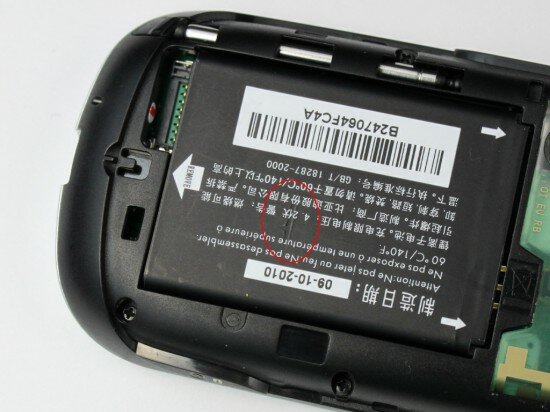
Pic. 11. Dents on the battery
Grade (stage 1): 3 (with 3 being the highest possible grade)
Grade (stage 2): 3 (with 3 being the highest possible grade)
Grade (stage 3): 3 (with 3 being the highest possible grade)
6. Breaking a cell phone in half (bending)
It seems that crushing and breaking in half are very similar actions. However, we think that stepping on a cell phone with your boots is not so dangerous as bending. If you try to break your handset in half you are likely to crack the screen glass and damage the innards. Deformation of the circuit board elements is the main reason of the phone’s malfunctioning.
This tme we did the following: we put the Alcatel OT-708 onto the two planks so that each edge of the phone lay on a single plank. Then we hitched a string with a 3 kg load (6.6 lbs) on top of the device. It’s clear that this little weight didn’t inflict any bend. But then we applied a 7 kg (15.4 lbs) weight in our attempt to break the phone. We didn’t see any bend again. The phone bended only under the 15 kg load (33 lbs). By the way, the handset bended more when we placed it face up. Speaking frankly, this bend was very small and the device showed no visible damage and stayed functional.
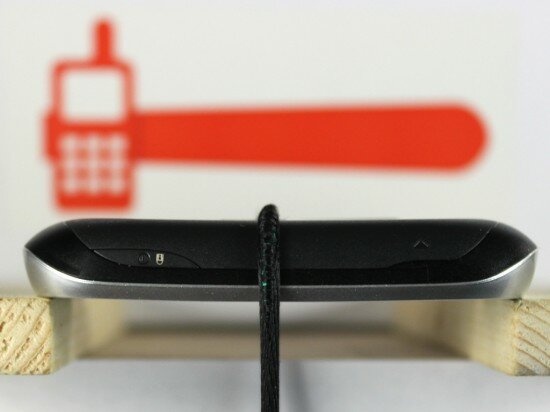
Pic. 12. Breaking the phone in half by applying the 15 kg (33 lbs) load on top of it (the phone was placed face down)
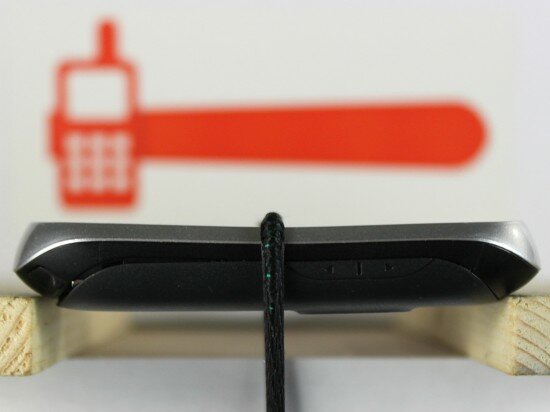
Pic. 13. Breaking the phone in half by applying the 15 kg (33 lbs) load on top of it (the phone was placed face up)
Grade (stage 1): 3 (with 3 being the highest possible grade)
Grade (stage 2): 3 (with 3 being the highest possible grade)
Grade (stage 3): 3 (with 3 being the highest possible grade)
7. Earphone cable testing (bending)
Unfortunately our headphones often loose function when their cable is damaged. We performed several experiments with the Alcatel’s earphone cable to check its reliability. At first we found out how it stands infinite bending. We used a special device that bended the cord for a lot of times (video 20). The whole test was divided into 3 stages: 500, 650 and 800 bends respectively. The earphones stayed absolutely functional after the test.
Video 20. Earphone cable testing (bending)
Grade (stage 1): 3 (with 3 being the highest possible grade)
Grade (stage 2): 3 (with 3 being the highest possible grade)
Grade (stage 3): 3 (with 3 being the highest possible grade)
8. Earphone cable testing (breaking the cord by by hanging different loads on it)
Wired earphones are not very comfortable to use and can be broken if you yank on the cord while it is plugged.
In this test we hung different loads on the cord like people hang their clothes on the clothesline. We started from a 1 kg load (2.2 lbs), then increased it to 2 kg (4.4 lbs) and at last hung a 3 kg (6.6 lbs) load on the cord (video 21). As you can see from the video, this didn’t break the cable. The earphones stayed functional.
Video 21. Breaking the cord by hanging different loads on it
Grade (stage 1): 3 (with 3 being the highest possible grade)
Grade (stage 2): 3 (with 3 being the highest possible grade)
Grade (stage 3): 3 (with 3 being the highest possible grade)
9. Dust test
If you have been using your cell phone for more than half a year you can probably find some grains of dust inside it. Dust makes electronic devices look unattractive. Moreover, it has a very bad impact on their performance. For example, cell phone’s speakers usually produce a low quality sound if their membranes get dirty.
We checked the Alcatel OT-708’s dust resistance by testing it in an enclosed tray containing dust. The whole experiment was divided into 3 stages lasted for 1, 3 and 6 minutes respectively. We threw the phone in the tray and made it vibrate viciously (video 22). After every stage, we examined the gadget.
Here’s how the Alcatel OT-708 looked like after the 1st stage of this test (Pic. 14). In general, the phone wasn’t as dirty as we expected. The back cover didn’t let much dust penetrate the phone (Pic. 15). The dirtiest place of the gadget was the USB port. However, we cleaned it with no problem because it is large (Pic. 16).
Next, we vibrated the tray for 3 minutes and were disappointed with the result. The volume rocker didn’t work properly any more. We tried to fix it but in vain. We solved this problem only when we disassembled the phone.
6 minutes of violent vibration made the phone look really dirty. Much dust penetrated the speaker (Pic. 17). Fortunately the membrane stayed clean and the sound quality wasn’t ruined. There was 2-3 times more dirt under the back cover than it was at the 1st stage of the test. But all this dust consisted only of tiny grains. The back cover clings tightly to the casing and doesn’t let large grains of dust penetrate the phone. Despite the problems with the volume rocker, the Alcatel OT-708’s dust resistance is at quite a satisfactory level.
Video 22. Dust test
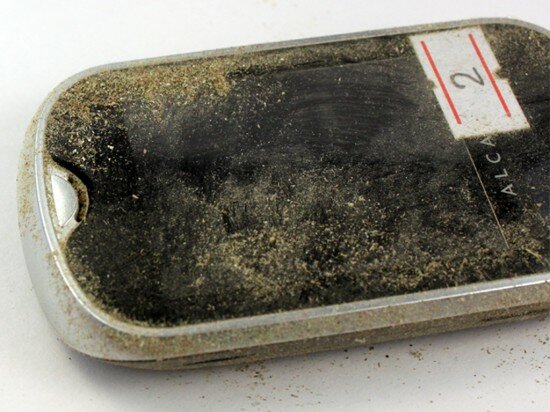
Pic. 14. Here’s how the Alcatel OT-708 looked like after the 1st stage of the dust test
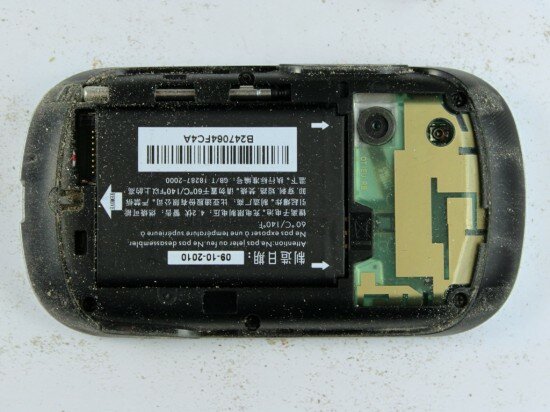
Pic. 15. Tiny grains of dust under the back cover (stage 1)
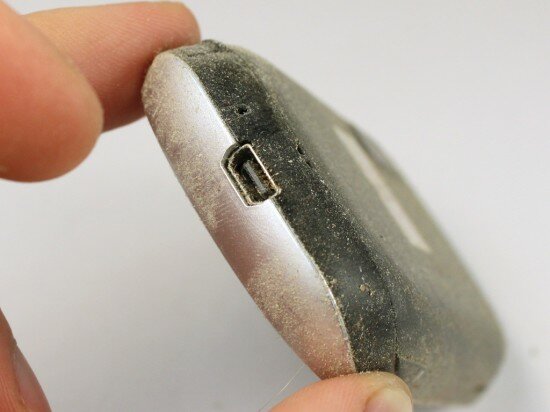
Pic. 16. Here’s how the USB port looked like after the 1st stage of the test

Pic. 17. Here’s how the speaker looked like after the 3rd stage of the dust test
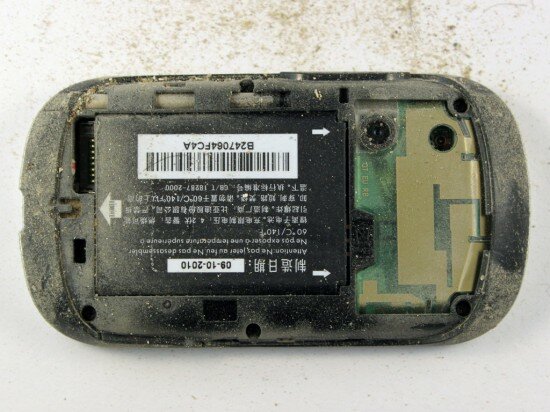
Pic. 18. Dust under the battery cover (stage 3)
Grade (stage 1): 3 (with 3 being the highest possible grade)
Grade (stage 2): 2 (with 3 being the highest possible grade)
Grade (stage 3): 2 (with 3 being the highest possible grade)
10. Durability of the front panel
In order to check durabilty of the phone’s front panel we placed it face down onto a vibrate pallet, specially devised for this test (video 23). We performed the experiment in three stages lasted for 5, 10 and 15 minutes respectively.
The Alcatel OT-708’s front panel sustained no visible damage. The phone successfully survived this test.
Video 23. Durability of the front panel
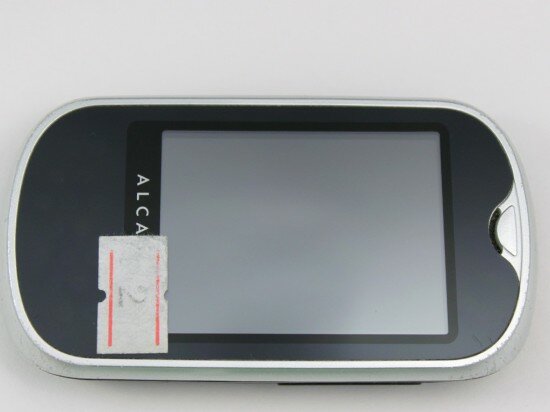
Pic. 19. The front panel sustained no visible damage
Grade (stage 1): 3 (with 3 being the highest possible grade)
Grade (stage 2): 3 (with 3 being the highest possible grade)
Grade (stage 3): 3 (with 3 being the highest possible grade)
11. Danger of carrying a phone in a pocket
Your mobile device can’t be absolutely safe even in your pocket. In order to prove this, we simulated what might be happening in a man’s pants pockets while carrying keys, pennies and a phone together.
We placed the keys, the pennies, some plastic balls and the Alcatel OT-708 inside a drum and rotated everything as fast as we could. Like the majority of the previous tests, this one was also divided into 3 stages: 5, 10 and 20 minutes.
We examined the phone after every stage of the experiment. After 5 minute test we took the gadget out of the drum, wiped dust off the screen and saw the scuffs on the glass, the scratches and dents on the back and front panels (Pic. 20, 21, 22). The material of which the phone is made leaves much to be desired. The low quality plastic is not durable at all.
Much more scuffs and scratches appeared on all parts of the phone during the 2nd test (Pic. 23).
The final test made the screen look unattractive (Pic. 24). The casing sustained some very deep and large scratches (Pic. 25).
Video 24. Danger of carrying a phone in a pocket
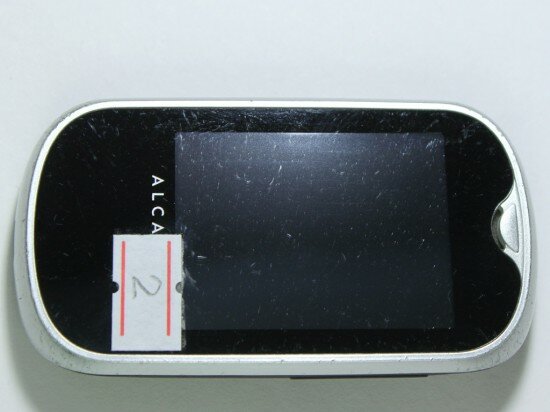
Pic. 20. Scuffs on the touchscreen (stage 1)

Pic. 21. Scratches on the back panel (stage 1)

Pic. 22. Scratches on the front panel (stage 1)
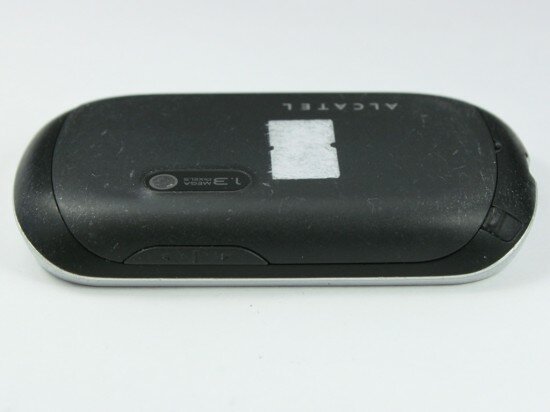
Pic. 23. Here’s how the phone looked like after the 2nd stage of the test

Pic. 24. Scratches on the screen (stage 3)
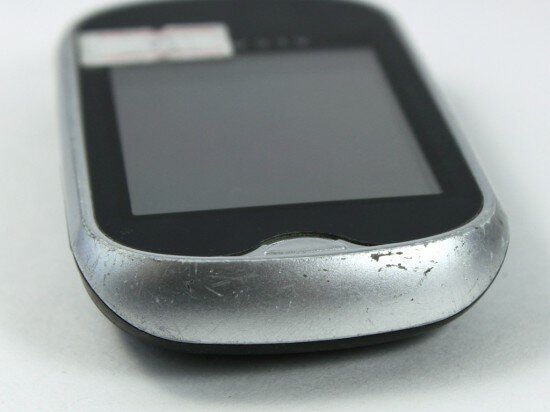
Pic. 25. Deep scratches on the steel coloured rim (stage 3)
Grade (stage 1): 2 (with 3 being the highest possible grade)
Grade (stage 2): 2 (with 3 being the highest possible grade)
Grade (stage 3): 2 (with 3 being the highest possible grade)
12. Scratch resistance of the screen
In order to check scratch resistance of the Alcatel OT-708’s screen we scratched it with a nail for 3 times. We locked the nail in the machine that was specially devised for this test and ran the phone over the sharp tip of the nail to make a scratch on the screen. Each time the machine applied a different force: 100 g (0.22 lbs), 300 g (0.66 lbs) and 600 g (1.3 lbs).
Scratch test of the screen (video 25 – 27).
The first scratch was almost invisible but the second and the third were quite large (Pic. 26). When we turned on the display backlight we could easily see all the scratches (Pic. 27).
Video 25. Scratching the screen at the force of 100 g (0.22 lbs)
Video 26. Scratching the screen at the force of 300 (0.66 lbs)
Video 27. Scratching the screen at the force of 600 (1.3 lbs)
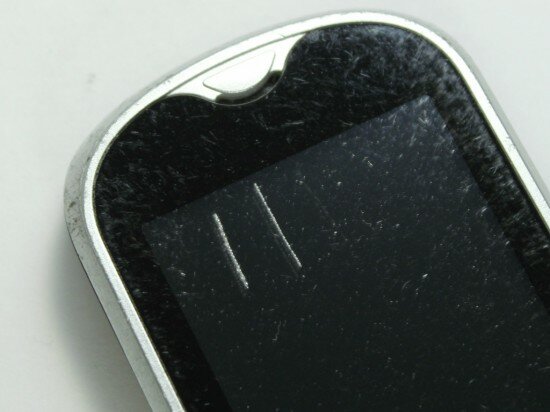
Pic. 26. Scratches on the screen
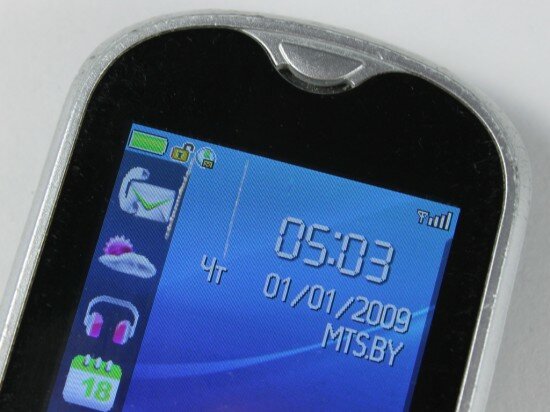
Pic. 27 Here’s how the screen looked like with the backlight on
Grade (stage 1): 3 (with 3 being the highest possible grade)
Grade (stage 2): 2 (with 3 being the highest possible grade)
Grade (stage 3): 2 (with 3 being the highest possible grade)
13. Scratch resistance of the back panel
The conditions of the back panel scratching were the same as for the screen. We already mentioned that the phone is made of a low quality plastic material. No wonder that all the scratches were visible (Pic. 28, video 28 – 30).
Video 28. Scratching the back panel at the force of 100 g (0.22 lbs)
Video 29. Scratching the back panel at the force of 300 (0.66 lbs)
Video 30. Scratching the back panel at the force of 600 (1.3 lbs)
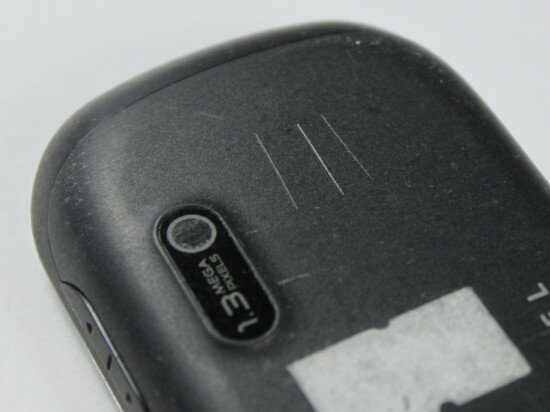
Pic. 28. Scratches on the back panel
Grade (stage 1): 2 (with 3 being the highest possible grade)
Grade (stage 2): 2 (with 3 being the highest possible grade)
Grade (stage 3): 2 (with 3 being the highest possible grade)
14. The screen’s ruggedization level – breaking the screen glass
Broken screen is one of the most often reasons for asking for a cell phone repair service. In this test we tried to break the Alcatel OT-708’s screen glass by dropping a small steel sphere on it. The diameter of the sphere is 15 mm (0.59 inches). We dropped it on the phone’s screen from 10 cm (3.9 inches), 20 cm (7.87 inches) and from 30 cm (11.8 inches). The phone sustained no damage. The resistive touchscreen served as a trampoline for the sphere making it jump off far away. The secret lies in the physical quality of resistive touchscreens which are less rigid than a simple protective screen glass.
Video 31. Breaking the Alcatel OT-708’s screen glass (10 cm (3.9 inches))
Video 32. Breaking the Alcatel OT-708’s screen glass (20 cm (7.87 inches))
Video 33. Breaking the Alcatel OT-708’s screen glass (30 cm (11.8 inches))
Grade (stage 1): 3 (with 3 being the highest possible grade)
Grade (stage 2): 3 (with 3 being the highest possible grade)
Grade (stage 3): 3 (with 3 being the highest possible grade)
15. Heat test
We performed the heat test in a can as usual. We placed the phone and the light bulb (40 Wt) very close together. Then we turned on the light bulb and allowed it to heat the Alcatel for the periods of 3, 5 and 10 minutes. So the whole test was divided into 3 stages (video 34-36).
The phone showed no damage. Its temperature was less than 100 °С (212 °F).
Video 34. Heating the phone for 3 minutes
Video 35. Heating the phone for 5 minutes
Video 36. Heating the phone for 10 minutes
Grade (stage 1): 3 (with 3 being the highest possible grade)
Grade (stage 2): 3 (with 3 being the highest possible grade)
Grade (stage 3): 3 (with 3 being the highest possible grade)
16. Touchpad and physical buttons
The Alcatel OT-708 has 3 physical buttons: power button and the volume rocker. All of them are comfortable to use because they aren’t raised much above the casing.
The buttons work fine in both hot and cold temperatures. They stayed functional after the water tests. But they are not dust resistant at all. Remember the problems with the volume rocker during the dust test.
The touchpad is situated at the bottom of the front panel. In fact, it is a part of the resistive touchscreen. We should say that this is not user friendly. If you had a phone with a tactile-feel keyboard you are likely to be confused by the Alcatel’s touchpad. You’ll have to get used to it.
Grade: 2 (with 3 being the highest possible grade)
17. Cell phone smash
Finally, we are goimg to fully smash the Alcatel OT-708 by dropping it on the tiles with each face, edge, and corner from 150 cm (4.9 ft), 200 cm (6.56 ft) and 240 cm (7.87 ft) (video 37 – 39).
We expected to see a spectacular show but the phone ruined our hope. It survived all the drops and sustained no damage.
Video 37. Drops on the tile from 150 cm (4.9 ft)
Video 38. Drops on the tile from 200 cm (6.56 ft)
Video 39. Drops on the tile from 240 cm (7.87 ft)
Grade (stage 1): 3 (with 3 being the highest possible grade)
Grade (stage 2): 3 (with 3 being the highest possible grade)
Grade (stage 3): 3 (with 3 being the highest possible grade)
18. Disassembling. Build quality
After all of the tests we disassembled the 2nd Alcatel OT-708 sample and checked the state of its innards and tried to solve the problem with the volume rocker.
The circuit board and particularly its element that is responsible for the work of the volume rocker got dirty in the result of the dust test (Pic. 29). That was the reason why the volume rocker malfunctioned. All the other components of the phone were OK.
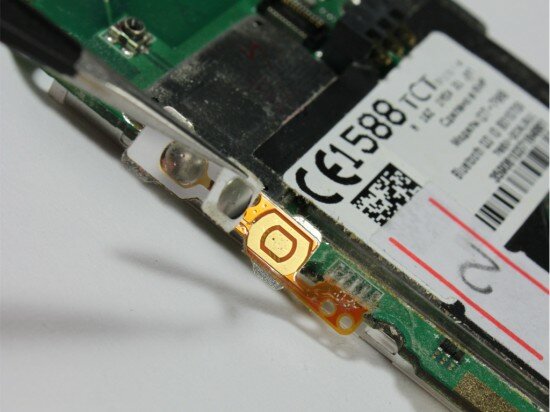
Pic. 29. Dirty part of the circuit board responsible for the volume rocker
Grade: 3 (with 3 being the highest possible grade)
All in all, the Alcatel OT-708 gains 681 point (with 895 being the highest possible grade)
Final words
In general, the Alcatel OT-708 provokes only positive emotions. This phone may seem too boring for an advanced mobile user. But its simplicity contributes to its reliability.
Among the gadget’s disadvantages we should single out the low quality plastic material of which the phone is made. The paint is also of a very low quality. The phone has a resistive touchscreen which can never be scratch proof. It sustained lots of scuffs and scratches. The volume rocker is also a weak part of the device as it malfunctioned after the dust test. The 750 mAh LI-Ion battery depletes quickly in the cold.
At the same time the Alcatel OT-708 survived all our hydrochemical attacks and stayed safe after the drop tests.
If you need a cheap touchscreen cell phone and haven’t made up your mind yet, we strongly recommend the Alcatel OT-708.
Here’s how the phone looked like after the tests (Pic. 30, 31, video 40).
Video 40. Here’s how both Alcatel OT-708 samples look like after the tests.
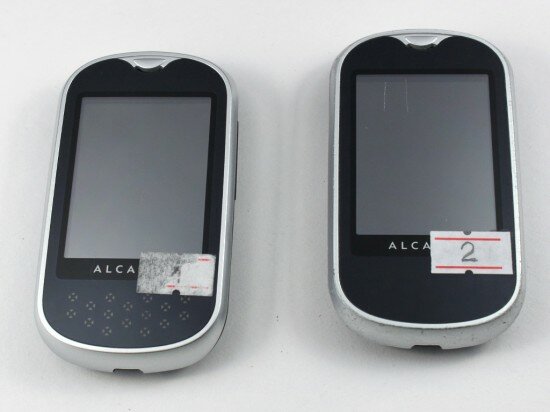
Pic. 30. Here’s how both Alcatel OT-708 samples look like after the tests (the front panels)
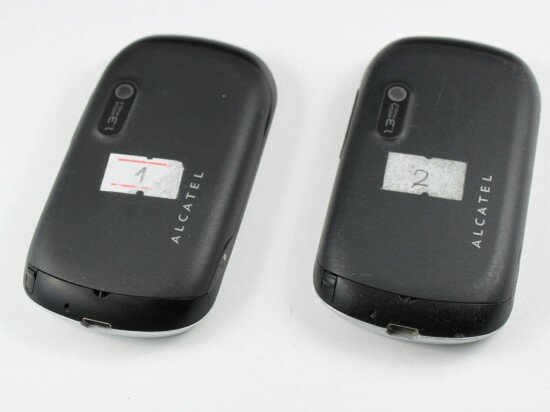
Pic. 31. Here’s how both Alcatel OT-708 samples look like after the tests (the back panels)

 Russian version
Russian version